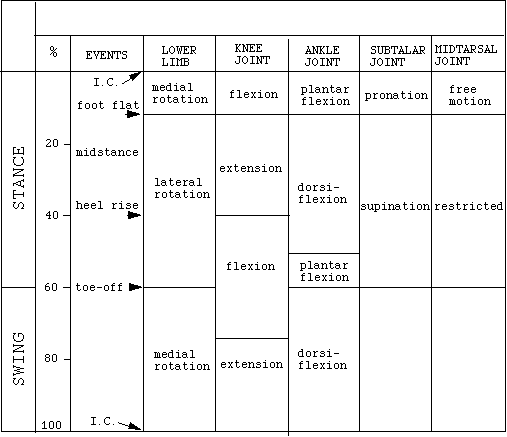Kinematic analyses
of gait
* denotes sections that contain background
material that is not included in course objectives.
Kinematic
measures of gait
kinematic variables describe the extent, speed, and direction of movement of
joints or body segments
·
step
length
·
stride length
·
velocity
·
cadence
Summary of gait kinematics
The chart (adapted
from Mann, 1975, Fig. 13-18, p. 266; Rodgers, 1988, Fig. 1, p. 1823; Chan &
Rogers, 1994; Mann & Mann, 1997, Fig. 7.24, p. 149) summarizes the
kinematic interactions that occur during the gait cycle. The chart's rows
distinguish between stance and swing phases.

Summary of
References
Chan,
C.W., & Rudins, A. (1994). Foot biomechanics
during walking and running. Mayo Clinic Proceedings, 69, 448-61.
Mann, R.A.
(1975). Biomechanics of the foot. In American Academy of Orthopaedic
Surgeons (Ed.), Atlas of orthotics: Biomechanical principles and
application (pp. 257-266). St. Louis: C.V. Mosby.
Mann, R.A., & Mann, J.A.
(1997). Biomechanics of the foot. In B. Goldberg & J.D. Hsu (Eds.), Atlas
of orthoses and assistive devices (pp. 135-152). St. Louis: C.V. Mosby.
Rodgers,
M.M. (1988). Dynamic biomechanics of the normal foot and ankle during walking
and running. Physical Therapy, 68, 1822-1830.
*The
determinants of normal and pathological gait
Features of the
movement pattern that minimize displacement in the body's center
of gravity during gait:
5.
Knee
Ankle Foot Interactions
Examples of how
these kinematic features produce an efficient walking pattern:
·
During
double limb support, that time when the center of gravity is at its lowest
point, joint angles in both lower extremities are such that their effective
lengths are maximized. Additionally, the pelvis is rotated forward on the side
where the limb is in loading response, and backward on the limb which is in preswing. This functional lengthening of the limbs
minimizes the vertical drop in the center of gravity.
·
During
midstance and midswing,
when the center of gravity is highest, the stance limb's hip, knee, and ankle
are all flexed 5 degrees. In addition, the pelvis is tilted downward laterally
toward the swing limb. This minimizes the center of gravity's upward excursion,
keeping it lower than if the individual were standing erect.
·
The
six "determinants" are logically appealing, because they help us
focus on a relatively small number of critical factors from among the many
degrees of mechanical freedom that are possible during walking. However, very
recent research questions whether the determinants are important, at least for
the reasons that Inman and Saunders proposed:
·
Kirtley, C. (Oct. 20, 1999). Frequently asked questions about
clinical gait analysis: Determinants of Gait. Retrieved March 27, 2001 from
August 24, 2000, from Clinical Gait Analysis web site: http://guardian.curtin.edu.au/cga/faq/determinants.html
·
Kerrigan,
D.C. (2001). Aesthetics of walking [Electronic version]. Journal
of Rehabilitation Research and Development, 38 (5), ix-x.
CENTER
OF GRAVITY DISPLACEMENTS
During ambulation, the
body's center of gravity is propelled forward. However it also moves vertically
and laterally; we presume a gait pattern to be energy efficient to the extent
that it minimizes vertical and lateral displacements.
I.
Vertical
displacement of COG
Viewed
in the sagittal plane, the vertical displacement of the center of
gravity traces a smooth sinusoidal curve. This curve's amplitude in the normal
adult male is approximately 5 cm or 2 inches. The center of gravity moves
vertically through two full oscillations during each gait cycle, so that the
curve has two peaks and two troughs.
·
The
low points or troughs in the sinusoidal pathway occur during the gait cycle's
two periods of double limb support (loading response and preswing).
The depth of the troughs is limited by:
·
Knee-ankle-foot
interactions
·
The
high points or peaks occur at midstance and again at midswing. The height of these peaks is limited by:
II.
Lateral
displacement of COG
The
center of gravity also oscillates laterally during ambulation. The total
lateral displacement traces a sinusoidal curve with an amplitude of
approximately 6 centimeters or 2.5 inches. The greatest lateral excursion of
the center of gravity occurs at the end of midstance.
Thus, only one full lateral oscillation of the center of gravity (to the right
and left) occurs during a gait cycle. The amplitude of this lateral excursion
is limited by a structural feature in the lower extremities, namely genu valgus.
To obtain a
complementary perspective, view Chris Kirtley's kinematics
web page, which covers some of the same material as this page.
Last updated
3-27-02 Dave Thompson PT
Introduction to the
study of walking
This is one of the first pages developed during this
web education project, which began February 20, 1996.
